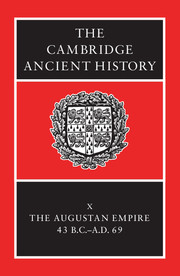13i - Roman Africa: Augustus to Vespasian
from 13 - The West
Published online by Cambridge University Press: 28 March 2008
Summary
BEFORE AUGUSTUS
If the province of Africa under the Roman Republic was not quite a land without a history, as Mommsen described it, it was certainly not central to Roman interests. The administration from the Punic town of Utica was rudimentary, largely a matter of supervising the local communities and contracting out the taxes. Nor is there much evidence of a military garrison apart from the small contingent with the governor. This did not, of course, prevent Roman and Italian immigrants from coming, whether as settlers on the land or as businessmen and tax-farmers. But the impression we get is that the numbers were not great, even in the coastal towns, where Roman enclaves formed. The official foundation of the colony of Carthage in 122 B.C. had been a disaster that had left stranded we do not know how many on its territory. Conservative Roman sentiment had resented the expense of the province and had feared to send out colonists. Evidence of Romans and Italians being settled by Marius is so thin that it is unwise to guess too much about their numbers, although some immigrants probably did arrive.
The only exception to this was the Gaetulian veterans of Marius, settled beyond the far borders of the province, who proved a valuable aid to Iulius Caesar in his campaigns in Africa in 46 B.C., and who were to be an important element in the new Augustan dispensation. During the civil wars between Pompey and Caesar a fair number of Romans took refuge in Africa. But even so, the Pompeians were hard put to it to raise 12,000 men and, even after reinforcements of 10,000 from Cyrene, they almost certainly had to include
Keywords
- Type
- Chapter
- Information
- The Cambridge Ancient History , pp. 586 - 618Publisher: Cambridge University PressPrint publication year: 1996
References
- 3
- Cited by

